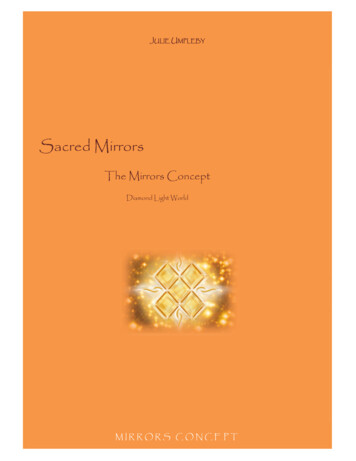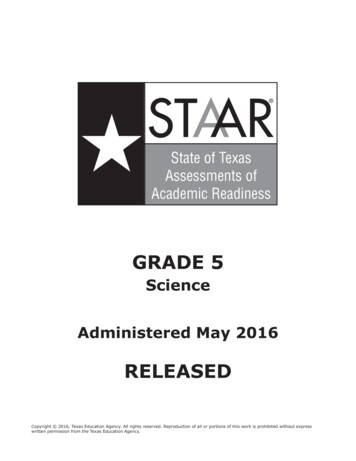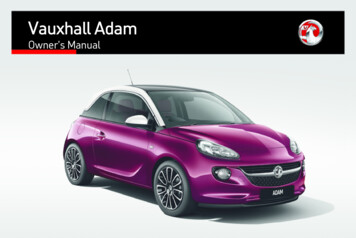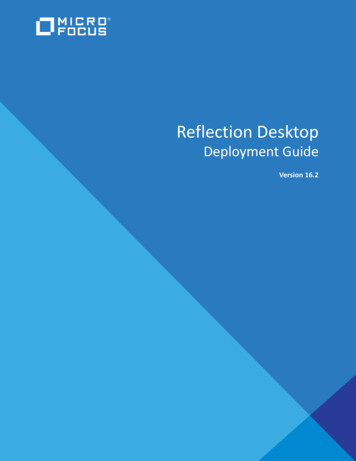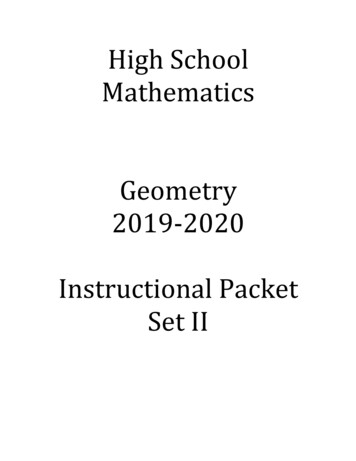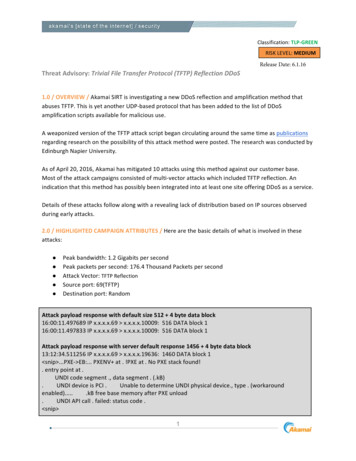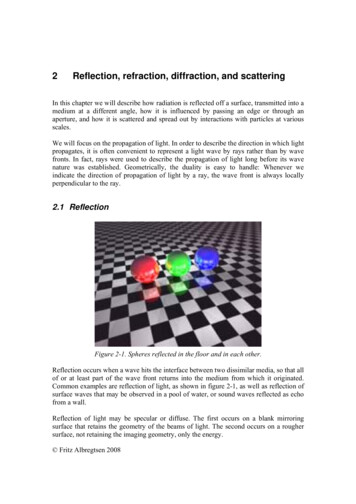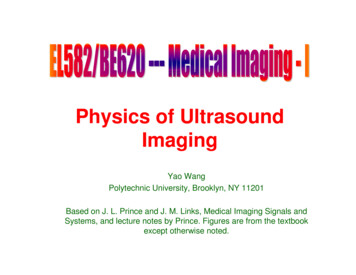
Transcription
CHILDREN, MIRRORS & REFLECTIONJos ElstgeestIntroductionMirrors are fascinating things to play with as well as to work with, for they hold anelement of magic. Magic and science seem to be at odds, but not necessarily tochildren. An exploration in to the reversed double world behind the looking glassmay well retain something of the thrill of the fairy tale and so provide a strongmotivation to pursue some real science. The fairy-tale mirror does not exist in thereal world. Every child knows that. But the mirror does and so does a child’swonder about its workings. It doubles whatever is in front of it; it shows you yourown face; it makes letters look funny and, at first, illegible; left right seem confused;it bounces sunlight into a bright spot on the wall; and in combination with anothermirror it seems to keep on reflecting reflections infinitely.Mirrors are universally and cheap to purchase; children can easily be introduced toborrow a mirror from home. Any piece of glass, especially when blackened on oneside, makes a workable, though not ideal mirror. Any shiny smooth surface canserve as a mirror. In fact, the shape and form of some ordinary shiny things, such asteapots, wheel hubs, reflectors, Christmas decorations or spoons add to the challenge,for they make things look different.The activities in this chapter need little introduction to the children: just provide themwith mirrors, and slowly structure and order their investigation. It is a unit of learningwhich entirely depends the children handling mirrors and other things they need. Bydirect experience and experimentation children will extract information from themirrors.It does not take long for children to start exploring when mirrors are placed in theirhands. A certain amount of free exploration as ‘a getting to know you’ exercise isessential. It focuses the children’s mind on an area of science, it generates initialquestions, it opens a perspective to ‘what you could like to know’ and . they do itanyway. However, free all over the place messing about is still somewhat removedfrom the scientific enquiry, which the children have to learn. The teacher is the onewho should bring order and system in children’s explorations and turn them intogenuine investigation. Having noticed the children’s interest and the direction inwhich it seems to go, the teacher intervenes. Sometimes the work is stopped altogetherand the class discusses possible lines of investigation, which have opened up.Sometimes the children are involved enough to be given individually or in smallworking groups a challenge in the form of a problem or a new piece of equipment.Questions and tasks may be given by word of mouth or by an appropriate worksheet.
In all cases, the work of the children is given more structure, direction and system; itis ready to become more scientific.This chapter presents a number of ideas for children to investigate various propertiesof mirrors and how they interact with light. A number of pages could be copied asthey are, and given to the children as worksheets. They suggest some problem andindicate how with the help of one or more mirrors solutions can be sought. Many ofthe ideas and tips given on other pages can be transferred to homemade work sheets.Any unit for children is a teacher’s resource. Many ideas and suggestions are givenbut they still need the creative teacher to turn them into children’s activities orinvestigations at the right time. Even readymade worksheets still need the judgment ofthe teacher as to where and when they should be employed and whether they shouldor should not be adjusted or extended. Worksheets are there to facilitate the work ofthe teacher; they are aids, tools for the teacher who retains responsibility to ensureeffective learning through the activities. The ‘figure card’ and ‘sample cards’ describeand need to be made by the teacher, after which they can be given to the children tosolve the problems they pose. Making sets of these cards is of course, a very goodteacher training activity. The technical problems of making sets of these cards isslight. Those who cannot draw can use very simple figures make a stencil or usesmall stickers. They are so many ways to make this easy that it should no body off.Apart from the work of composing pictures-to-be-matched, one is compelled tothink. Perhaps, there should be ‘easy’ as well as ‘tough’ sets; what makes a scale ofdifficult from simple to hard? Would you include a few cards with an impossibleproblem? It would not be bad for the children to realize that in the world of mirrorsthere are things that just do not work. Mirrors with all their magic obey strict physicallaws. A few impossible figure or sample cards may start a lively discussion as well asprovide an opportunity to review and summarize the children’s findings and ideas sofar.There is no definite sequence in activities provided here. The teacher should use heror his own judgment on what to start with and how and with what to continue. Theteacher can add activities and inevitably the questions of the children will lead to thinknot included here. It will be helpful to have other sources and books at hand and usethem as the occasion arises. Periscopes, lateral inversion and angles of incidenceamong others, have been left out because they can be found in every school textbook.Itsounds rather ambitious to expect primary school children to understand the physicsof light and reflection yet by way of encounter and interaction with mirrors it isentirely possible. Of course, reflection means little or nothing to children unless it isthere, present in the mirror they hold in their hand, changing when they change theposition of that mirror or multiplying when they move another mirror nearby.Accumulated experiences, encouraged or suggested by the teacher, ordered and
reflected upon in discussion, formulated in words by recording, and given specificmeaning as verification of some hypothesis may order themselves into patterns ofunderstanding; and ideas of a higher level of abstraction may evolve in the minds ofthe children. They may find that searching behind the looking glass may not be magicin order to be satisfying and rewarding.These worksheets are about doing with mirrors; about gettingchildren to interact with mirrors. You will not find “lesson aboutmirrors in them” You will not even find very useful informationabout mirrors. What you will find are a few starters to get childrento investigate and solve problems with the help of mirrors.Once the children are off on their investigations, be prepared for allsorts of questions. Don’t let this alarm you, for either: (a) the mirrorwill provide the answer (and it is good to learn how to ask themirror); or (b) you know the answer, which makes it ease or (c)there are books available which provide an answer; or (d) theanswer is simply not known, by you nor by anybody else. Well, letit be so.Mankind is still learning, and we are not omniscient. That, too, is avery good lesson for our children. Periscopes, lateral inversion,angles of incidence and like bits of language and technology havebeen left out, you can find these in every school textbook. So usethese terms where appropriate and called for by the interest andquestions of the children.
Mirrors and ReflectionsWhat shinesand mirrors allaround?This is a good starting question.Many surfaces shine and reflect light,some more, some less than mirrors. Allhelp to understand how light is reflected.“Reflectivity?.”Write down five objects,seen from where you sit,and place them, in orderof “reflectivity”.Could you make a listof mirror words?- Mirror- ShineLook for things, which show ordo what these words describe.Examine these objects and try tofind words which further explaintheir reflective qualities, such as- Reflect- Smooth- Radiate- Polished- Bounce- Waxed- Glisten- Varnished- Gleam- Glassy- Glint- Level- Polish- Flat- Sparkle- Unruffled- Image- BaldClean Shave?This helps children to developan eye for (relevant) physicalproperties of things.Besides it helps them to discusssensibly about their observations.
Sit around with your children and discuss all together your experiencesand observations; raise questions, suggest possible answers,propose experiments and agree on what to do, on who does what,on how to go about it and how it all should be recorded and communicated.How do thingsbecome likemirrors?Boy! Glass mirrorsperfectly! Just look atit from an angle.Ripples in the water makeit a funny mirror. You get aripple face in it.Spoons and teapotsand water kettles arefine mirrors, like myspecs!And my eyes!Kitchen foilreflects, but itdoes not mirror.Little shiny roundthings like buttonmake things lookever so tiny.So do my shoes,provided I havepolished them!An aquarium is a fine mirror.Look at the surface frombelow. Everything swimsupside down?
Mirrors?What makes amirror a mirror?Oh, but then we needlots of mirrors to dothings with!Ask the mirror what?That is the way to ask the mirror, so see to it thatthere are sufficient mirrors available:a) Bring some yourselfb) Ask the children to borrow all sorts ofmirrors from home. Small ones, big ones;mirrors which enlarge or diminish; rear viewmirrors; spoons, coffeepot lids, buttons,Christmas decorations, copperplate, buckles,bumpers, as long as it mirrors.c) Let the children work in groups so they canwork with each others mirrors, and shareideas and experiences.Questioning, doing, trying, figuring out and renewed questioning will follownaturally.What follows consists of tips, ideas, suggestions, and gentle nudges - Some pages may be photocopied as worksheets for the children.Remember: these are only starters!Add and change whatever you want:You and your children are the boss!
Children can do a lot with mirrorsJust give them mirrors and watch .Who me?With the mirrorsyou can lookbehind your ears.In the mirror You can look at yourself (or others)You can look round a corner.You can look in your mouth.If you hold a mirror above your eyes or your head:1. Everything looks upside down.2. And in this upside down worldYou can walk and jump;Shake your hands,Walk through a line of chairs or stools,Place something in a matchbox and put iton the table.3. You can try and follow a snaky line on theground.Draw the line or use a rope or a garden hose.Rules:Never step on itKeep it between your legsNever look at itUnless through the mirror.4. How long can you stand on one legin your topsy-turvy world?
Try and walk through theschool building (and out ofit by the front door) holdinga mirror under your chin:look in to the mirror heldsteady, and facing upwards.With two mirrors you can .Well,What can you do with twomirrors held at an angle?Can you make a fullface out of a half?Try this:Place something small between twomirrors held upright at an angle.Count the images and measure the angle.Change the angle and count the imagesagain.Note what you get at1800 : .images900 : images600 : images450 : images300 : images900Look at yourself in this900 combination Then wink at yourself.Can you explain this?Make this into a simple graph – x axis(angle); y axis (number of images)Can you now figure out a formula,which gives you the number of imagesfor any angle?
Write your name in mirror script(that is: so that you can read it in the mirror.)You are allowed to use tricks, but do tryit without tricks first.You may write “mirror words”On paperOn the floor, the ground,On the blackboard.Which letters of the alphabet do not change in the mirror?Can you write whole words,which do not change in the mirror?.Or a sentence
Mirror scrabbleUPSIDEDOWNA mirror reverts things.That is whymirror letterslook so funny.LaterallyBCDEHIKOXATIVHMWOXHold the mirror along this line to reflect the letters on the left.Hold the mirror on this line to reflect the letters above.Can you make a whole word which looksthe same in the mirror?Or a sentence?With the letters on the left you may makevertical words.And you would make palindromesAny idea what apalindrome is?Oh no!
DICK BOXED BEDEMAMACopy this sheet for the children.Glue the letters on thin cardboard, and cut them out.Now you can make mirror scrabble wordsCould you invent a mirror-scrabble-game?IMake up your own TTUUUUVVVVWWWWXXXYYY‘‘
How many mice can you make with?- One mirror?- Two mirrors?- Three mirrors?- More mirrors?What difference(s) do you see when you“multiply” the first or the second mouse?Draw or describe:a) The position of the mirrors.b) How the mice are sitting.What more can you do and find out withmice and mirrors?And what do you get when:- You mirror tiny mice?- Or a picture of yourself?- Or a pencil?- Or ?- Or you can take anything.MOUSEEven with the word “mouse” you can makesomething nice using two (or more) mirrors.Try it and draw the result.
DRAWWhat you can make out of each of these figures and a mirror.LS
DRAWThe figures (left) as you will see them when you place a mirror on the line.Only after drawing can you check with your mirror and see how “correct” you are.
TAKE A sizable mirror and hold it firmly above your eyes, or high in front,so that you, looking in the mirror, look down upon this paper.Then following the instructions underneath.Did we go in, ordid we ‘just’ comeout of that pub?
MIRROR-WORK & PROBLEM CARDSWith any picture and any mirror you can makemany pictures.1. Paste, faces, houses, trees, landscapes onthin cardboard and see what it becomeswhen you slide a mirror across it in anydirection . just for the fun or to challenge one another.2. A real problem cardUse a mirror and this clock to make:a) Breakfast time.b) School time.c) Dinner time.d) Bed time.e) Free time.f) No time, or any time.
3. Figure CardsYou need one “figure card”:Figure cardAnd a set of problem cards.The problem is:With which of these cards and a mirror –can you reproduce the figure on the figure card?
3. Sample Card ProblemsThis is another set of problem cards whereby a mirror is used with the “samplecard” only.The problem is: try and copy the configurations found on the other cards.(Can you, or can you not?)Sample cardN.B.These are only a fewexamplesYou can make manymore.Make various such sets.Perhaps a nice projectfor helpful parents ?Famous last words?
The problem of the Mirror WallImagine you are in a room one wall of which is one huge mirror.You are in the company of a solitary vase of flowers.MirroredRoomMirror WallRoomYourselfVase of flowersYou stand at the spot indicated on this planand you are looking in the mirror at the vase of flowers.Sketch in pencil the direction in which you are looking.After drawing your “lineof vision” by all means,do check with a mirror. .But do not getconfused.
The problem of the Rear-view MirrorShine or tempest, my car is parked outside. I had not washed it forquite sometime too long, and so it happened that my rear viewwindow looked somewhat grimy A naughty, little neighbor boy scribbled on it with a wet finger:At first I did not notice anything until I boarded my vehicleand looked into my rear-view mirror What exactly did I see?Fill into this mirrorimage of my rearwindow what Iactually did see.Rear-view mirrorwith mirror image ofrear-windows.Please, how do you explain this?
The Flexible MirrorFlexible sheets of thin shiny metal or plasticized foil make beautifulflexible mirrors, but these are not easy to obtain.A sheet of acetate – overhead projector transparency – fixed onto a darkblack paper makes a very good substitute.Position yourself facing a source of light (a lamp or a window) andhaving a darker, shadowy, background, and look at yourself in theflexible mirror.What do you see, if you flex it Like this Or this .Or this .Or this .Or this .Or this .Place a newspaper headline in front of your flex-mirror.What do you see?And what do you see,if you flex the mirror?ConvexConcaveDraw Here
Talking about your work & experience is very important.Allow children, as a matter of course, tomuse and share ideas and problems.You can shine thesun from yourmirror on the wall.How come I amupside down in aspoon?But you are rightside up on theback! Much smallerthough!From how far?Oh, ever so far!And a square mirrorshines around!In the bumper ofmy dad’s car I amawfully fat andugly. Yeah!You can see thebottom of a fly ifyou make him walkon a mirror!You can play “catch”on the wall. You musttry and touch myshiny patch!I can look over theheads of grownups with mymirror!I can bounce the sunthrough your mirrorback in my face!END
mirror it seems to keep on reflecting reflections infinitely. Mirrors are universally and cheap to purchase; children can easily be introduced to borrow a mirror from home. Any piece of glass, especially when blackened on one side, makes a workable, though not ideal mirror. Any shiny smooth surface can serve as a mirror.
